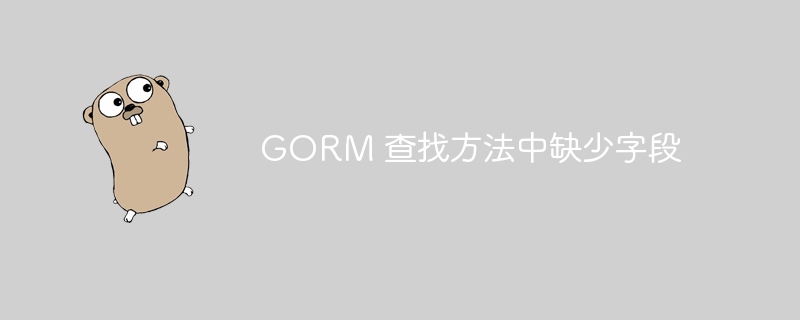Missing fields in GORM lookup method

php editor Xinyi sometimes encounters a problem when using GORM: in the search method, the returned results are missing some fields. This may be because we did not add a label to the field when defining the structure. In GORM, you can specify how fields are mapped in the database by using tags. Therefore, in order to solve this problem, we need to add the correct label to each field in the structure to ensure that the values of all fields can be returned correctly when querying.
Question content
Trying to use the GORM method find to get the values of the database table, but it does not return the values of all fields. The table structure is,
CREATE TABLE `company` ( `id` varchar(36) NOT NULL, `createdAt` timestamp NOT NULL DEFAULT CURRENT_TIMESTAMP, `updatedAt` timestamp NOT NULL DEFAULT CURRENT_TIMESTAMP, `name` varchar(255) NOT NULL, `newId` varchar(255) NOT NULL, PRIMARY KEY (`id`) ) ENGINE=InnoDB DEFAULT CHARSET=utf8;
In company.go, we define the company structure as,
package entities
import "time"
type Company struct {
Id string `json:"id" gorm:"column:id;primaryKey"`
CreatedAt time.Time `json:"createdAt" gorm:"column:createdAt"`
UpdatedAt time.Time `json:"updatedAt" gorm:"column:updatedAt"`
Name string `json:"name" gorm:"column:name"`
NewId string `json:"newId" gorm:"column:newId"`
}In the controller companies.go, use the following code to get the data,
var companys []entities.Company
result := db.Find(&companys)
c.JSON(http.StatusOK, &result)In Postman, it only returns the values of the fields name and id. The remaining fields have empty values. What could be the problem?
I tried to get all fields using GORM's find method but it only gives two fields
The data in the table is as follows,
Workaround
As stated in the documentation, createdAt and updatedAt are managed by GORM, so you can leave Tag gorm?
The above is the detailed content of Missing fields in GORM lookup method. For more information, please follow other related articles on the PHP Chinese website!

Hot AI Tools

Undresser.AI Undress
AI-powered app for creating realistic nude photos

AI Clothes Remover
Online AI tool for removing clothes from photos.

Undress AI Tool
Undress images for free

Clothoff.io
AI clothes remover

AI Hentai Generator
Generate AI Hentai for free.

Hot Article

Hot Tools

Notepad++7.3.1
Easy-to-use and free code editor

SublimeText3 Chinese version
Chinese version, very easy to use

Zend Studio 13.0.1
Powerful PHP integrated development environment

Dreamweaver CS6
Visual web development tools

SublimeText3 Mac version
God-level code editing software (SublimeText3)

Hot Topics
 Go language pack import: What is the difference between underscore and without underscore?
Mar 03, 2025 pm 05:17 PM
Go language pack import: What is the difference between underscore and without underscore?
Mar 03, 2025 pm 05:17 PM
This article explains Go's package import mechanisms: named imports (e.g., import "fmt") and blank imports (e.g., import _ "fmt"). Named imports make package contents accessible, while blank imports only execute t
 How to implement short-term information transfer between pages in the Beego framework?
Mar 03, 2025 pm 05:22 PM
How to implement short-term information transfer between pages in the Beego framework?
Mar 03, 2025 pm 05:22 PM
This article explains Beego's NewFlash() function for inter-page data transfer in web applications. It focuses on using NewFlash() to display temporary messages (success, error, warning) between controllers, leveraging the session mechanism. Limita
 How to convert MySQL query result List into a custom structure slice in Go language?
Mar 03, 2025 pm 05:18 PM
How to convert MySQL query result List into a custom structure slice in Go language?
Mar 03, 2025 pm 05:18 PM
This article details efficient conversion of MySQL query results into Go struct slices. It emphasizes using database/sql's Scan method for optimal performance, avoiding manual parsing. Best practices for struct field mapping using db tags and robus
 How do I write mock objects and stubs for testing in Go?
Mar 10, 2025 pm 05:38 PM
How do I write mock objects and stubs for testing in Go?
Mar 10, 2025 pm 05:38 PM
This article demonstrates creating mocks and stubs in Go for unit testing. It emphasizes using interfaces, provides examples of mock implementations, and discusses best practices like keeping mocks focused and using assertion libraries. The articl
 How can I define custom type constraints for generics in Go?
Mar 10, 2025 pm 03:20 PM
How can I define custom type constraints for generics in Go?
Mar 10, 2025 pm 03:20 PM
This article explores Go's custom type constraints for generics. It details how interfaces define minimum type requirements for generic functions, improving type safety and code reusability. The article also discusses limitations and best practices
 How to write files in Go language conveniently?
Mar 03, 2025 pm 05:15 PM
How to write files in Go language conveniently?
Mar 03, 2025 pm 05:15 PM
This article details efficient file writing in Go, comparing os.WriteFile (suitable for small files) with os.OpenFile and buffered writes (optimal for large files). It emphasizes robust error handling, using defer, and checking for specific errors.
 How do you write unit tests in Go?
Mar 21, 2025 pm 06:34 PM
How do you write unit tests in Go?
Mar 21, 2025 pm 06:34 PM
The article discusses writing unit tests in Go, covering best practices, mocking techniques, and tools for efficient test management.
 How can I use tracing tools to understand the execution flow of my Go applications?
Mar 10, 2025 pm 05:36 PM
How can I use tracing tools to understand the execution flow of my Go applications?
Mar 10, 2025 pm 05:36 PM
This article explores using tracing tools to analyze Go application execution flow. It discusses manual and automatic instrumentation techniques, comparing tools like Jaeger, Zipkin, and OpenTelemetry, and highlighting effective data visualization






